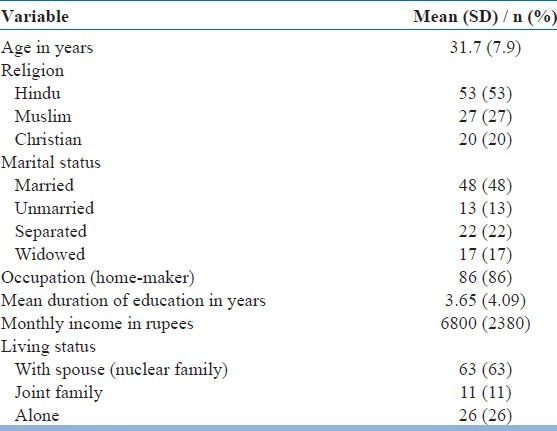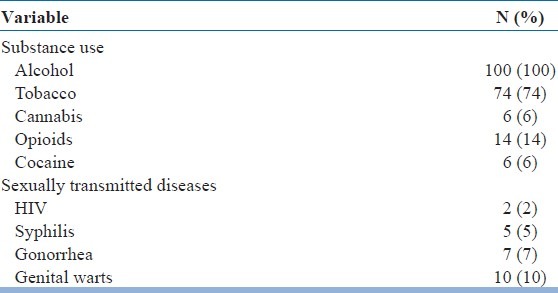Abstract
Introduction:
Substance abuse may act as precursors and also can form outcomes of sexual behaviors. The confluence of drug use, mental stressors, poverty, sexually transmitted diseases, low self-esteem and high-risk partners forms a fertile ground for psychological morbidity.
Aim:
To assess the psychological morbidity among female commercial sex workers (CSWs) who use alcohol and other substance abuse.
Materials and Methods:
One hundred consecutive CSWs with alcohol and drug abuse patients attending the psychiatric OPD at Victoria hospital were assessed clinically. Relevant investigations were also carried out. General health questionnaire and substance use disorder identification tests were administered.
Results:
A total of 100 cases between 30-40 years of age were taken up for the study. All were abusing alcohol with tobacco chewing or smoking being (64). Eighty-seven were married. Fifty of them being illiterate. Seventy-eight were suffering from physical illness. Two were HIV patient on treatment. Seventy-eight were having psychological morbidity (depression and adjustment disorder).
Conclusion:
Preventive interventions, targeting substance abuse and stimulating healthier-environments and providing economically independent.
Keywords: Female commercial sex workers, substance abuse, psychological morbidity
INTRODUCTION
There is a strong relationship between mental ill-health, risk-taking behaviors, drug use and sexual behaviours among commercial sex workers.[1] Prostitution is associated with a host of psychosocial vulnerabilities, including exposure to childhood physical abuse, childhood sexual abuse, interpersonal violence in adulthood and substance uses.[2] As described by Medrano and Gilchrist, prostitution is often linked with socio-demographic disadvantages like minority ethnic status, low income, homelessness and low education level.[3,4] Because of its complexity and multifaceted nature, prostitution poses significant challenges to clinicians and researchers.
Western studies show a high degree of mental health morbidity among this population. Vanwesenbeeck showed that in a sample of 96 CSWs, the prevalence of depression was 73%, post-traumatic stress disorder was 30% when compared to those among female nurses being 53%.[5] Amanda R(2005 ) reported the presence of 87% depressive symptoms ranging between mild and severe while more than half (54%) reported severe current depressive symptoms. (74%) of the sample reported having ever thought about suicide, and less then half (42%) reported having tried to kill themselves.[6] Psychiatric morbidity is also found to be more among female commercial sex workers.[7] Research on mental morbidity of CSWs in India is very few. Bhat found a prevalence of neurotic disorders to be 45% in a sample of 82 CSWs attending a general health camp. Out of these, 94 % had depressive disorders.[8] Aim: To evaluate psychological morbidity among female commercial sex workers with alcohol and drug abuse.
MATERIALS AND METHODS
Sample: One hundred consecutive patients attending the psychiatry outpatient department of the Victoria hospital, Bangalore were assessed between January and August 2008. Assessments:
Socio demographic profile
Clinical interview to confirm the clinical diagnosis
General health questionnaire
Abuse use disorder identification test
Relevant clinical investigation.
RESULTS
The marital status of our study populations was extremely good, 87% were married. In spite of the good marital status majority were not living with their spouses. Out of them 22 were separated from their husbands and 17 were widows. Most of them were home workers and their mean income per month was 6800 per month. The literacy of the population was also very poor. Although they hail from urban set up only 50% were literate. The patients showed not good family support and 63 were hailing from a nuclear family. Twenty-six were living alone on their own [Table 1].
Table 1.
Sociodemographic details

In the study population all were using alcohol. Seventy-four percent were using tobacco. Fourteen % were using opiods and 12% were on cannabis and cocaine. Twenty-two % were suffering from sexually transmitted diseases. Only 2% were suffering from HIV [Table 2].
Table 2.
Pattern of substance abuse and sexually transmitted diseases

We found the remarkable percentage of 71% were suffering from depression. The depression is because of the profession and also the stresses faced being an alcoholic. The patients were not revealing their profession due to the consequence of being known to others. The guilt of being into this profession was also causing them depression. 73% were suffering from social dysfunction. It was the consequence of being an alcoholic and also the stresses they faced being a commercial sex workers. Anxiety was also 42% for various reasons [Table 3].
Table 3.
General health questionnaire

The study population showed that many were suffering from physical illness. Seventy-eight percent were suffering from various physical illnesses. Fourteen percent were suffering from Hepatitis. Seventy-eight percent were treated for various sexually transmitted diseases [Table 4].
Table 4.
Physical comorbidity

DISCUSSION
Our study shows that there could be significant mental health morbidity among CSWs who sought treatment for alcohol use problems. This study showed that age for seeking help is fourth decade. Most of their husbands were alcoholics. Which resembles number of studies on women's drinking has found a positive association between women's level of alcohol consumption and those of the partners.[9] The strong influence of husbands on their wives drinking is consistent with the study of Haavio & Mannilas.[10] Twenty-two women were separated from their husbands. Seventeen women were widows. Pitiable circumstances, sad family background, a greater number of children to support suggests that commercial sex workers with substance abuse have poor social support. Although 62 were from nuclear families, heavy burden of care in terms of cost, domestic work, economic responsibilities had lured them in to sexual business. Fifty of the study population were illiterate, which is similar to study, the less well-educated individuals and those with lower occupational status drink less frequently than those with higher incomes, they tend to drink more at each session as reported in a study by Caswell.[11] The average study population's earning was Rs. 5000-10, 000 per week.
Studies by Morgan[12] and Hill[13] have demonstrated the vulnerability of women to physical illness. In this study, 78 were having physical illness, of them 14 were suffering from alcohol-related liver damage.
St. Petersburg of Russia described multiple sexual partners, low rates of condom use, concomitant use of intoxicants prior to sex, unsafe injecting practices, injecting in groups, borrowing/lending needles/syringes were the common causes of sexually transmitted disease. Seventy-eight cases of the study population were treated for sexually transmitted disease. Ninety-eight reported that they have been screened for HIV, out of them two were diagnosed and on treatment for HIV. Reza-Paul[14] found that 26% of sex workers in the city of Mysore were HIV-positive but this study had only two positive cases. (The reasons could be majority were reported to be using condoms, and the sample size was very small). Depression was reported in 78% of the study population. Chaudhary & DAS[15] reported significant depression and anxious disorders in their alcoholic sample. Forty-two were suffering from anxiety disorders. In this study, they were anxious of their identity about them to their family members, police, clients, physical illness and HIV. Poor economic background, alcoholic husbands, domestic and sexual violence, premarital sex were the causes reported by the study population for their social dysfunction and adjustment problems. Somatic symptoms are reported in 39 of the study population. They were cardiac, gastrointestinal, pain local and generalized. Somatic symptoms were expression of under lurking depression or anxiety. They reported to have consulted medical help with no improvement. They were guilty of their profession and the stresses related to it were causing many somatic symptoms. Significant past illness present history of mental illness was present in 16 cases of the study population were: Dysthymia-7, MDD-1, BPAD-4, Adjustment disorder-4. But only six were on treatment.
Number of studies have noted that alcohol and tobacco are the most frequently used substances, accounting for the vast majority of drug-related morbidity and mortality.[16] Nicotine dependence was found in 64 cases in the study population.
CONCLUSION
Preventive interventions includes: targeting alcoholism, drug consumption, reducing risk factors, stimulating healthier environments involving all social factors which can significantly modify their drug dependence and to help women save money to become economically independent.
Limitation
Firstly the study population is small. Its under-representative due to the problems gaining access to sex workers and establishing trust. As a result, researchers are reliant on individuals who attend sexual health clinics voluntarily, who may be poor representatives of the local CSW population, particularly the more vulnerable groups. Secondly, there is likely to be reporting bias in response to questionnaires or structured interviews on drug habits. Finally, CSW represent an unstable population both temporally and geographically, which means prospective studies are difficult to conduct without the loss of significant numbers of subjects, which itself may in bias result.
Footnotes
Source of Support: Nil
Conflict of Interest: None declared.
REFERENCES
- 1.Kelly JA, Murphy DA, Baker GR. Factors associated with severity of depression and high risk sexual behavior among persons diagnosed with HIV infection. Health Psychol. 1993;12:215–9. doi: 10.1037//0278-6133.12.3.215. [DOI] [PubMed] [Google Scholar]
- 2.Burnette ML, Lucas E, Ilgen M, Frayne SM, Mayo J, Weitlauf JC. Prevalence and Health Correlates of Prostitution Among Patients Entering Treatment for Substance Use Disorders. Arch Gen Psychiatry. 2008;65:337–44. doi: 10.1001/archpsyc.65.3.337. [DOI] [PubMed] [Google Scholar]
- 3.Medrano MA, Hatch JP, Zule WA, Desmond DP. Childhood trauma and adult prostitution behavior in a multiethnic heterosexual drug-using population. Am J Drug Alcohol Abuse. 2003;29:463–86. doi: 10.1081/ada-120020527. [DOI] [PubMed] [Google Scholar]
- 4.Gilchrist G, Gruer L, Atkinson J. Comparison of drug use and psychiatric morbidity between prostitute and non-prostitute female drug users in Glasgow, Scotland. Addict Behav. 2005;30:1019–23. doi: 10.1016/j.addbeh.2004.09.003. [DOI] [PubMed] [Google Scholar]
- 5.Vanwesenbeeck I. Burnout among female indoor sex workers. Arch Sex Behav. 2005;34:627. doi: 10.1007/s10508-005-7912-y. [DOI] [PubMed] [Google Scholar]
- 6.Roxburgh A, Degenhardt L, Copeland J. Posttraumatic stress disorder among female street-based sex workers in the greater Sydney area, Australia. BMC Psychiatry. 2006;6:24. doi: 10.1186/1471-244X-6-24. [DOI] [PMC free article] [PubMed] [Google Scholar]
- 7.Bassel N, Schilling RF, Irwin KL, Faruque S, Gilbert L, Von Bargen J, et al. Sex trading and psychological distress among women recruited from the streets of Harlem. Am J Public Health. 1997;87:66–70. doi: 10.2105/ajph.87.1.66. [DOI] [PMC free article] [PubMed] [Google Scholar]
- 8.Bhatt S, Jayaprakash, Shenoy MM, Vinay M, Bhavaniskar M. A study on mental health of sex workers Paper Presentation at ANCIPS Jaipur. 2009 [Google Scholar]
- 9.Wilsnack RW, Wilsnack SC, Klassen AR. Women drinking and drinking problems. Am J Public Health. 1984;74:1231–8. doi: 10.2105/ajph.74.11.1231. [DOI] [PMC free article] [PubMed] [Google Scholar]
- 10.Haavio Mannila E, Konlula OW, Martin S, Sprecher S. Sex, alcohol and gender: a study of Finnish University students. Nord Sexol. 1990;8:268–81. [Google Scholar]
- 11.Casswell S, Pledger M, Hooper R. Socioeconomic status and drinking pattern in young adults. Addiction. 2003;98:601–10. doi: 10.1046/j.1360-0443.2003.00331.x. [DOI] [PubMed] [Google Scholar]
- 12.Morgan MY, Sherlock S. Sex related differences among 100 patients with alcoholic liver disease. Br Med J. 1977;1:939–41. doi: 10.1136/bmj.1.6066.939. [DOI] [PMC free article] [PubMed] [Google Scholar]
- 13.Hill SY. In: Alcohol problems in Women. Wilsnack SC, Beckman LJ, editors. New York: Guilford Press; 1984. [Google Scholar]
- 14.India's National Newspaper Saturday. [Last accessed on 2006 Oct 07]. available from http://209.85.175.104/search?q=cache:gWqQbOcm4jgJ:siteresources.worldbank.org/INTSAREGTOPHIVAIDS/Resources/PratimaMurthy.pps+commercial+sex+workers+drugs&hl=en&ct=cln (MAP 2005, UNDCP 2002a). k&cd=39&gl=in&client=firefox-a (Rezapaul 2005)
- 15.Chaudhary S, Das SK, Ukil B. Psychologicaal assessment of alcoholism in males. Indian Journal of Psychiatry. 2006;48:114–7. doi: 10.4103/0019-5545.31602. [DOI] [PMC free article] [PubMed] [Google Scholar]
- 16.Bonomo Y. Adolesen alcohol and Other Substanc use: sharing the Australian experience. Ann Acad Med Singapore. 2003;32:29–35. [PubMed] [Google Scholar]


